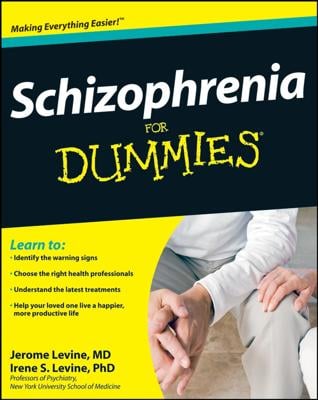The most common form of psychosis is schizophrenia. Psychiatrist Eugene Bleuler used the term schizophrenia in 1911 to describe people who exhibited signs of disorganized thought processes, a lack of coherence between thought and emotion, and a state of disconnection from reality.
Today, the DSM-5 criteria for schizophrenia include:
Delusions: A delusion is a firmly held belief that a person maintains in spite of evidence to the contrary. One common type of delusion is a paranoid or persecutory delusion, which involves intense fear that you’re being followed, listened to, or otherwise threatened by someone or something. Mr. Smith appears to be experiencing a paranoid delusion. He “knew” that the neighbor was out to get his house!
Hallucinations: A hallucination can be defined as a perception that occurs without external stimulation that is experienced as very real. Hallucinations can be auditory (hearing voices or sounds), visual (seeing people who are not there, demons, or dead people), olfactory (smells), gustatory (tastes), or somatic (experiencing physical sensations within the body).
Command hallucinations are a potentially dangerous form of auditory hallucination because they involve a voice or voices telling the sufferer to do something, often involving violent or suicidal behavior.
Disorganized speech and thought: If you’ve ever had a conversation with someone, and you had no idea what she was talking about, you may have witnessed disorganized speech and thought, which are characterized by extremely tangential (mostly irrelevant), circumstantial (beating around the bush), or loosely associated (jumping from one unrelated thought to another) speech. These abnormal styles of communicating may be evidence of a thought disorder.
Grossly disorganized or catatonic behavior: When a person behaves in a disorganized manner, she may act extremely silly or childlike, easily get lost or confused, stop caring for herself and her basic needs, do strange or bizarre things like talk to herself, or be extremely socially inappropriate. Catatonic behavior involves complete immobility, absolute lack of awareness of one’s surroundings, and sometimes being mute.
Negative symptoms: A negative symptom refers to the absence of some usual or expected behavior. The absence of the behavior is what is abnormal. Three negative symptoms are often associated with schizophrenia:
Flat affect: When a person exhibits no emotionality whatsoever
Alogia: Indication that a person’s thought processes are dull, blocked, or generally impoverished
Avolition: When a person has no ability to persist in an activity; looks like an extreme lack of motivation
Schizophrenia is diagnosed in about 4 to 5 of every 1,000 people. Generally the condition is diagnosed in individuals between the ages of 18 to 35. Sometimes, but rarely, it’s diagnosed in childhood. Schizophrenia typically begins in the late teens and early twenties and is fully present by the mid- to late twenties.
It can develop rapidly or gradually, and there can be periods of less severe symptoms. Some sufferers are chronically and persistently ill. Periods of illness can be characterized by a marked inability or diminished capacity to function in everyday life, often leading to school failure, job loss, and relationship difficulties.
Schizophrenia’s causes
Are the causes of schizophrenia organic (biochemical/physiological) or functional (resulting from experience)? At the moment, perhaps because of the wide array of newly developed brain-scanning techniques, the organic explanations are far more prominent. However, the best answer may lie in a synthesis of the two points of view. The main theory in practice today is the diathesis-stress model, which merges two different areas of research.
First, some definitions. A diathesis is a predisposition to a particular disease. Stress can be defined as any number of psychological and social factors. So, the diathesis-stress model holds that schizophrenia is the consequence of a stress-activated diathesis or predisposition.
Proposed biological diathesis for schizophrenia includes problems with brain chemistry and/or development. Researchers have found malformed parts of the brain in people with schizophrenia. These biological abnormalities can lead to problems with thinking, speech, behavior, and staying in contact with reality.
For the stress component, psychological factors address the reality distortion associated with schizophrenia. Some experts propose that the world experienced by someone with schizophrenia is so harsh, and its conflicts so intense, that the person needs a vacation from it. Research supports that psychic trauma, such as child abuse, can be related to psychotic breakdowns, and it certainly constitutes a harsh reality that inspires an escape.
A social factor related to schizophrenia that has shown promise in recent research is a phenomenon known as expressed emotion. Expressed emotion (EE) refers to negative communication by family members directed at the person suffering from schizophrenia. EE often consists of excessive criticism. Family members may comment on the patient’s behavior, “You’re crazy!” for example. EE also includes emotional over-involvement of family members that can overwhelm the patient.
Treatment of schizophrenia
Schizophrenia is one of the most difficult mental disorders to treat. Its effects are often debilitating for both the individual with the disease and his family. Approaches to treating this illness range from medication to helping individuals develop important functional skills such as money management or social interaction methods.
Antipsychotic medications such as Haldol and Zyprexa are typically the first line of treatment for people suffering from schizophrenia or related psychotic disorders. Although they are extremely beneficial, these medications are known as palliatives because they don’t cure disease; they just lessen the intensity of symptoms.
Psychosocial treatment and rehabilitation have also shown promise in managing schizophrenia. Patients learn social and self-care skills that can help reduce the number of stressors they face.
Although seemingly out of fashion in recent years (too labor-intensive and therefore too expensive), psychotherapy, specifically cognitive therapy, has been used in recent years to teach patients to challenge their delusional belief systems and become better “consumers” of reality.

